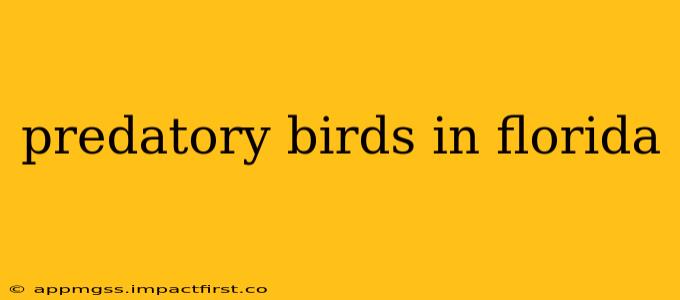Florida's diverse ecosystems support a rich variety of predatory birds, from majestic eagles to stealthy owls. These avian hunters play a vital role in maintaining the balance of nature, controlling populations of rodents, reptiles, and other animals. This guide explores some of the most common and fascinating predatory birds found throughout the Sunshine State.
What are some common predatory birds found in Florida?
Florida is home to a wide array of predatory birds. Some of the most commonly sighted include:
-
Bald Eagles: These iconic birds of prey are a symbol of the United States and thrive in Florida's abundant wetlands and coastal areas. They primarily feed on fish, but also consume birds, turtles, and other animals.
-
Osprey: Often found near water bodies, ospreys are specialized fish-eaters. Their exceptional diving skills make them highly efficient hunters. You'll frequently spot them perched on utility poles or nesting platforms along Florida's waterways.
-
Red-shouldered Hawks: These medium-sized hawks are common in forests and wooded areas across Florida. They prey on a variety of animals, including snakes, rodents, frogs, and insects. Their distinctive red shoulders make them easily identifiable.
-
Great Horned Owls: These large owls are nocturnal hunters, utilizing their exceptional hearing and silent flight to ambush prey. They consume a wide range of animals, from rodents and rabbits to snakes and even other birds.
-
American Kestrel: This small falcon is one of the smallest falcons in North America. They are acrobatic hunters, often hovering in mid-air before diving to capture insects, small birds, and rodents.
What is the largest predatory bird in Florida?
The Bald Eagle holds the title of the largest predatory bird commonly found in Florida. With a wingspan reaching up to 7 feet, these impressive birds are a magnificent sight to behold.
What is the smallest predatory bird in Florida?
The American Kestrel is among the smallest predatory birds commonly found in Florida. Their compact size allows them to maneuver with remarkable agility during hunting.
Where can I see predatory birds in Florida?
Predatory birds can be spotted throughout Florida's diverse habitats. Some excellent locations for birdwatching include:
-
Everglades National Park: This vast wetland provides habitat for a wide variety of birds, including Bald Eagles, Osprey, and various hawk species.
-
Corkscrew Swamp Sanctuary: Known for its old-growth cypress forest, this sanctuary offers excellent opportunities to observe Red-shouldered Hawks and other birds of prey.
-
** Merritt Island National Wildlife Refuge:** Located near the Kennedy Space Center, this refuge is home to a significant population of Bald Eagles.
-
Various state parks and wildlife management areas: Florida's extensive network of parks and preserves offer many opportunities for birdwatching.
What are the threats to predatory birds in Florida?
Like many wildlife species, Florida's predatory birds face several threats:
-
Habitat loss: Development and deforestation reduce available nesting and hunting grounds.
-
Pesticide use: Exposure to pesticides can weaken birds and affect their reproductive success.
-
Lead poisoning: Ingestion of lead shot from hunting can be fatal to birds of prey.
-
Collisions with vehicles and power lines: These accidents can result in serious injuries or death.
Conserving Florida's predatory birds requires protecting their habitats, reducing pesticide use, and promoting responsible hunting practices.
How can I help protect predatory birds in Florida?
You can contribute to the conservation of predatory birds by:
-
Supporting organizations dedicated to wildlife conservation.
-
Practicing responsible outdoor recreation.
-
Educating others about the importance of bird conservation.
-
Reducing your use of pesticides.
-
Reporting injured or orphaned birds to wildlife rehabilitation centers.
By working together, we can ensure that these magnificent birds continue to thrive in the Florida landscape for generations to come. Protecting these apex predators is crucial for maintaining the health and balance of Florida's ecosystems.
